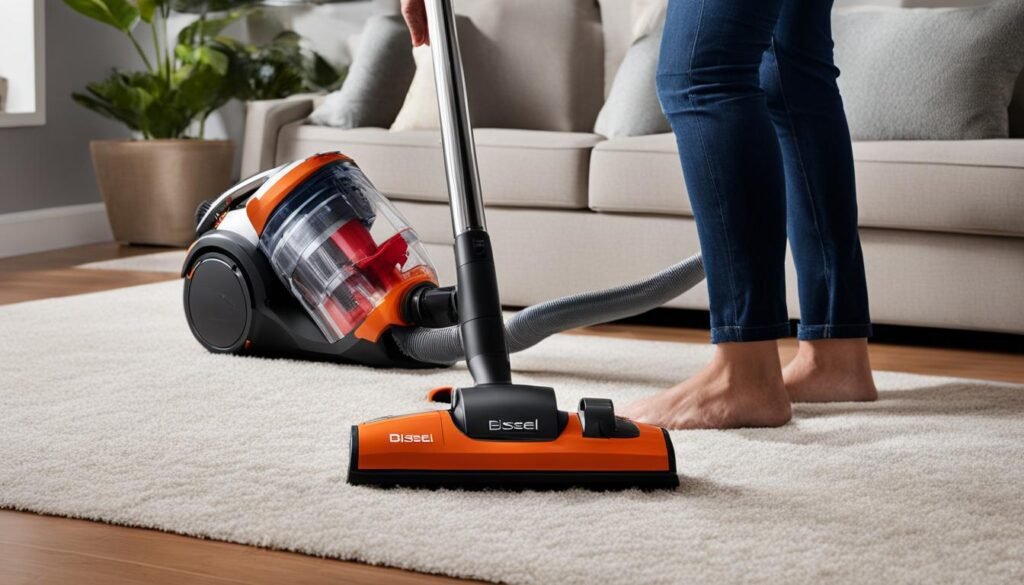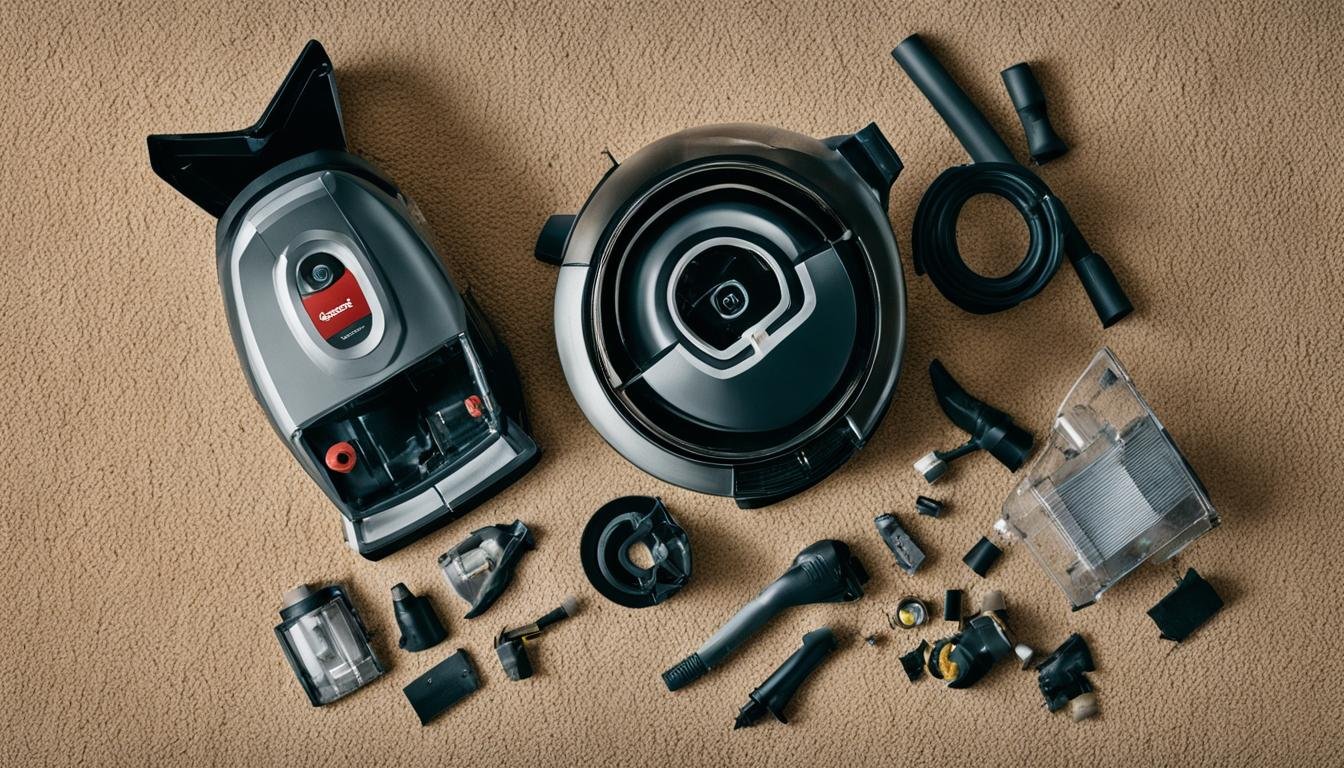If you’re experiencing issues with your Bissell vacuum cleaner, I’m here to help. Whether you’re facing problems with the brush not turning, no power, low suction, or dirty filters, there are troubleshooting and repair steps you can take to fix the problem and keep your Bissell vacuum cleaner running smoothly.
Regular maintenance and understanding the common issues and their solutions can save you time and money. In this article, I will guide you through the process of troubleshooting and repairing your Bissell vacuum cleaner, ensuring it stays in optimal working condition for years to come.
Key Takeaways
- Regular maintenance and troubleshooting can help fix common issues with your Bissell vacuum cleaner.
- Address brush issues by checking for obstructions, adjusting the height knob, and ensuring proper functionality.
- Power and suction problems can be resolved by checking for power supply issues, cleaning filters, and removing obstructions.
- Remember to follow the manufacturer’s instructions and seek professional assistance if needed.
- Performing regular maintenance and addressing issues promptly can extend the lifespan of your Bissell vacuum cleaner.
Troubleshooting Brush Issues
One common issue with Bissell vacuum cleaners is when the brush does not turn or becomes hard to push. This can greatly affect the overall cleaning performance of your vacuum cleaner. If you’re experiencing this problem, there are several troubleshooting steps you can take to address it.
To begin, start by unplugging the machine from the power source for safety. Then, recline the handle of your Bissell vacuum cleaner to gain access to the brush area. You may notice that the brush is obstructed by debris or tangled hair, which can cause it to stop turning. In that case, it’s essential to remove these obstructions to restore the brush’s functionality.
Using a screwdriver, carefully unscrew the screws in the brush area to gain access to the brush roll. Once you’ve removed the brush roll, take the time to clean it thoroughly. Remove any debris, hair, or tangled fibers that may have accumulated and prevented the brush from turning freely.
Additionally, while inspecting the brush area, you can also check the height adjustment knob. The height adjustment knob allows you to customize the height setting of the brush according to the type of flooring you’re cleaning. Ensure that the knob is adjusted correctly to the appropriate setting, as an incorrect height adjustment can cause the brush to struggle or not turn at all.
By addressing these issues in the brush area, such as removing obstructions and checking the height adjustment knob, you can ensure that the brush on your Bissell vacuum cleaner is functioning properly. This will ultimately improve the overall performance and efficiency of your vacuum cleaner, allowing you to achieve the best cleaning results for your home.
Tips for Fixing Brush Related Issues:
- Unplug the machine and recline the handle to access the brush area
- Remove any obstructions, such as debris or tangled hair, from the brush
- Thoroughly clean the brush roll to ensure smooth rotation
- Inspect the height adjustment knob and adjust it to the appropriate setting
“Taking the time to clean the brush area and make sure the height adjustment is correct can make a big difference in the performance of your Bissell vacuum cleaner.” – Bissell vacuum cleaner owner
By following these troubleshooting steps and implementing the tips provided, you can effectively resolve brush-related issues with your Bissell vacuum cleaner. Remember to always prioritize safety and read the manufacturer’s instructions for the specific model of your vacuum cleaner.
Resolving Power and Suction Problems

If you’re facing power or suction issues with your Bissell vacuum cleaner, there are troubleshooting steps you can follow to address the problem.
Troubleshooting Power Issues
If your Bissell vacuum cleaner has no power or the lights are flashing, begin by checking for any flashing lights on the machine. This indicates a potential power issue. Test the outlet and charger by plugging them into a different power source or trying a different appliance to verify if they are functioning properly.
If there is no power, run your hand along the power cord and inspect it for any visible damage or loose connections. Additionally, check the plug for any signs of wear or damage.
If the power issue persists despite these checks, it may be necessary to consult an authorized Bissell service center for further assistance.
Troubleshooting Suction Issues
If you’re experiencing suction problems with your Bissell vacuum cleaner, start by testing the suction at the end of the hose. If there is little to no suction, it may indicate an obstruction in the hose or brush area.
Inspect the hose for any clogs or blockages, ensuring it is clear of any debris. Check the brush area as well, and remove any tangled hair, threads, or other objects that may be preventing the brush from rotating properly.
Another common cause of suction issues is dirty filters. Regularly cleaning the filters is crucial for maintaining optimal suction performance. Refer to the manufacturer’s instructions on how to clean the filters properly for your specific Bissell vacuum cleaner model.
Conclusion
Troubleshooting and fixing your Bissell vacuum cleaner doesn’t have to be complicated. By following the tips and solutions provided, you can address common problems like a brush not turning, power issues, and suction problems. Regular maintenance, such as cleaning filters, can also help prevent these issues from occurring. However, if you find yourself unable to resolve the problem on your own, it is advisable to seek assistance from an authorized Bissell service center.
With the right knowledge and steps, you can keep your Bissell vacuum cleaner in optimal working condition for years to come. By utilizing DIY Bissell vacuum cleaner repairs, you can save time and money while ensuring that your cleaning routine remains uninterrupted. Remember, taking the time to troubleshoot and address any problems as they arise will help prolong the lifespan of your Bissell vacuum cleaner and keep it running efficiently.
Whether it’s the brush not turning, power issues, or suction problems, don’t let Bissell vacuum cleaner problems frustrate you. With these tips for repairing Bissell vacuum cleaner, you can tackle the most common issues head-on. By embracing an active approach to maintenance and repairs, your Bissell vacuum cleaner will continue to serve as a reliable and indispensable cleaning tool in your home.
FAQ
What should I do if the brush on my Bissell vacuum cleaner is not turning or is hard to push?
First, unplug the machine and recline the handle. Then, unscrew the screws in the brush area to remove any obstructions. Additionally, check the height adjustment knob and change the setting if necessary.
How can I troubleshoot power and suction problems with my Bissell vacuum cleaner?
If there is no power or the lights are flashing, check for flashing lights and test the outlet and charger. If there is no power, run your hand along the power cord and check the plug for damage. For suction issues, test the suction at the end of the hose and check for obstructions. Cleaning the filters is also important for maintaining suction.
What can I do to prevent issues and maintain my Bissell vacuum cleaner?
Regular maintenance, such as cleaning filters, can help prevent problems with your Bissell vacuum cleaner. It is also recommended to seek assistance from an authorized Bissell service center if you are unable to fix the issue on your own.





Leave a Reply